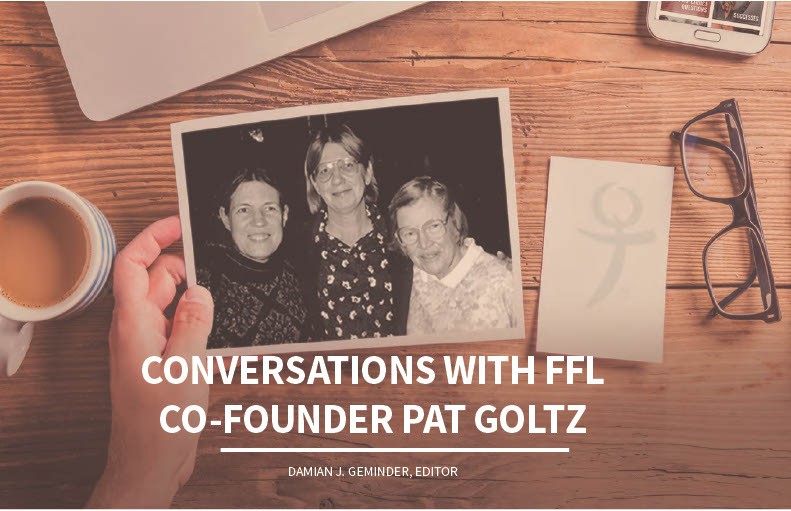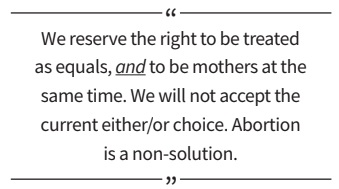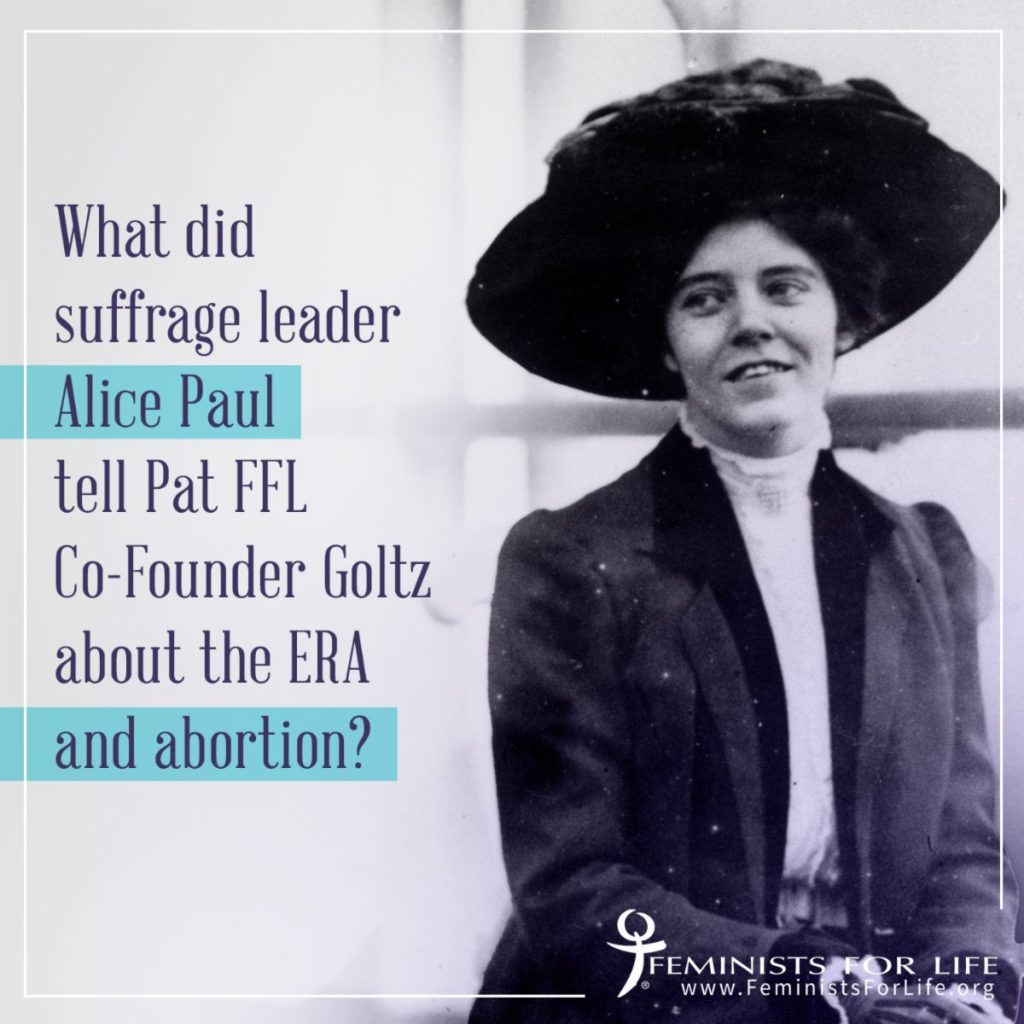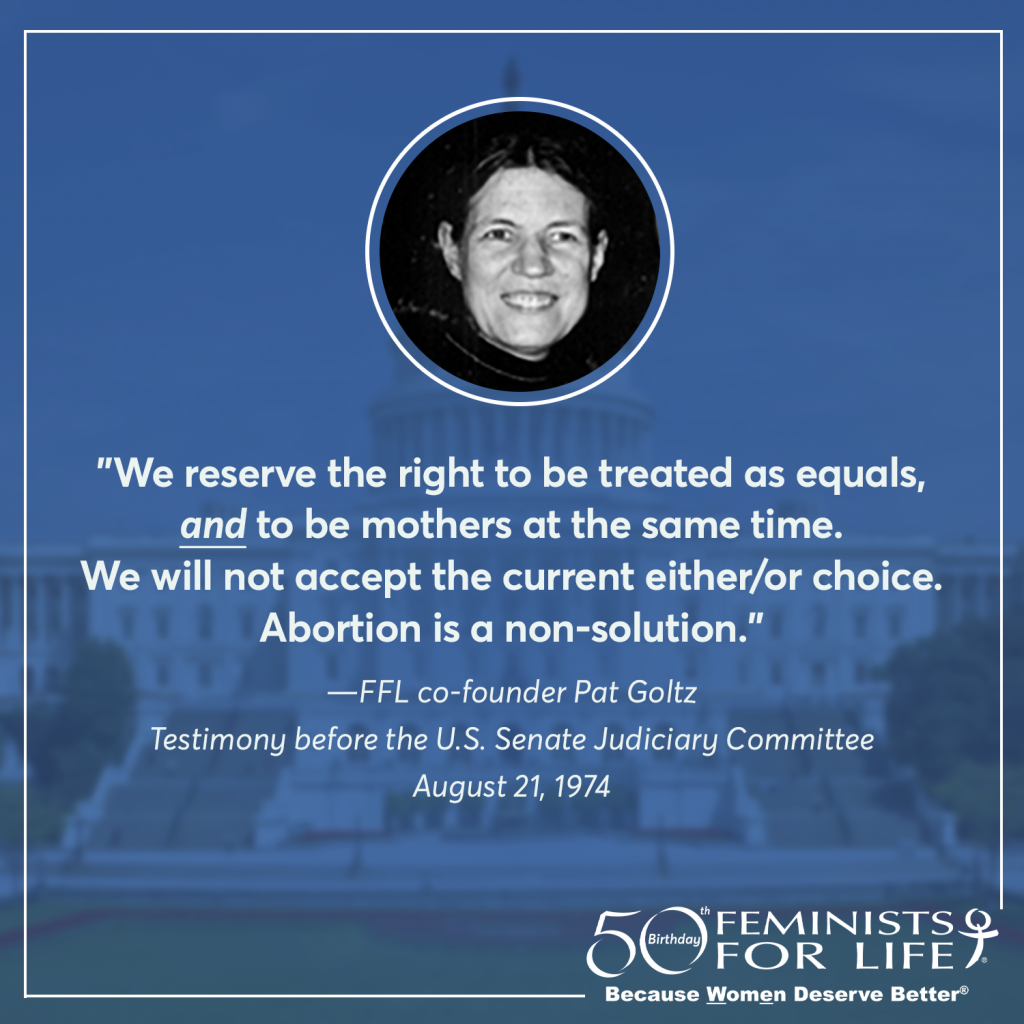
From left to right: FFL co-founder Pat Goltz, FFL Board President Rosemary Bottcher, and FFL co-founder Cathy Callaghan, pictured in 1997 at FFL’s 25th anniversary celebration in Washington D.C.
Conversations with FFL Co-Founder Pat Goltz
Damian J. Geminder, Editor
The movement to liberalize abortion laws in the United States was spearheaded by men, but it initially made only so much headway during the mid-20th century. It was the politically shrewd strategy of NARAL co-founders Lawrence Lader and Dr. Bernard Nathanson to recruit the women leaders of the nascent second-wave feminist movement that seemed to do the trick, shifting the national conversation and the locus of the pro-legal abortion argument from one of medical necessity to one of civil rights.
Their first major public relations victory was hijacking the second meeting of the National Organization for Women (NOW) on November 18, 1967. As Sue Ellen Browder revealed in her interview with FFL President Serrin M. Foster in “Beyond the Schism: Reclaiming Feminism,” on that fateful night in the Chinese Room at the Mayflower Hotel in Washington D.C., feminists on both sides of the abortion issue debated for hours, but the pro-life representatives gave up and left when they realized the deck was stacked against them. In the end, just 57 people voted for a resolution in support of legalizing abortion, following a resolution in support of the Equal Rights Amendment (ERA).
The ERA’s author, Alice Paul, who had led the women’s suffrage movement to victory nearly a half-century earlier, arrived at the meeting late in the night. Paul was a staunch opponent of abortion, and in turn, she rejected attempts to interpret the ERA as establishing a constitutional right to abortion. But she was too late to influence the outcome of the meeting, and the next day, the press ran with headlines declaring that the women’s movement was now an abortion advocacy movement.
The 1970s was a decade of revolution: political, cultural, sexual. The country was still embroiled in a land war in Asia. Trust in long-established institutions was eroding like never before.
Indeed, while there is no consensus about which decade of the 20th century was the most consequential for the United States, it is undeniable these 10 years were a period marked by radical change, much of which had been set in motion during the 1960s, if not earlier. Among the social changes rippling through the American landscape were the many states curtailing or even outright overturning their abortion bans. In 1970, Hawaii became the first state to legalize abortion-on-demand, and New York—at the time the second-most populous state—soon followed.
Also in 1970, a young woman named Pat Goltz joined the Columbus, Ohio, chapter of NOW. Pat had always identified as both a feminist and pro-life. In an interview with WORLD magazine, she discussed her upbringing1:
I resented the fact that my parents tried to keep me from doing certain things because I was female. My mother forbade me from taking chemistry and told me I had to take home economics or study hall. Whenever I did something I thought they might forbid me to do, I didn’t tell them I was doing it. In high school, my future husband made me a code oscillator so I could practice Morse code and get an amateur radio license. He liked to build electronics from old parts, and we’d put equipment together whenever we weren’t at the movies for a date. I hid the oscillator from my parents and only used it when they weren’t around. Basically, I became a feminist because people discriminated against me for being interested in science….
My parents were pro-life, and I was always pro-life. When I was in high school, I learned what abortion was and was horrified. I am aware that we are made in the image of God and God alone has the right to decide when a person lives or dies. Science tells us that an unborn child is a human being and that life begins at the moment of fertilization.
Pat hoped NOW would see abortion from her pro-woman, pro-life perspective. She did manage to talk them into hosting a pro-life speaker, and she tried to make them welcoming of children by providing child care for a conference and taking her breastfeeding baby to meetings. Unfortunately, none of these efforts changed the local leadership’s minds, and Pat soon understood that she needed to found a new, pro-life feminist organization.
This vision was realized two years later, when she befriended Cathy Callaghan, as Pat recounted2:
Cathy and I met over a judo mat. I was just starting, and she had a brown belt. She eventually earned a black belt in judo, and I think also in karate. I eventually earned a green belt in judo, a purple belt in Kem Scrima Doh, and a second degree black belt in taekwondo.
At first, Cathy wasn’t interested in feminism, since she had a Ph.D. in linguistics (she worked with the Lake Miwok Indians in California), and felt other women could also achieve. But I pointed out that not everyone has been able to achieve as she had. She was always against abortion, as was I. I persuaded her the feminist movement was needed for the women who were unable to achieve as she had. She achieved in spite of the barriers to women.
On March 16, 1972, The Columbus Citizen-Journal ran an article in its “Women’s Features” section, “Favor Life: Form Another Feminist Group,” discussing the founding of FFL and featuring a picture of Pat and Cathy, its co-founders. The two set out to build up membership but found initial success outside of NOW3:
Not long after forming the group, Cathy and I attended an Ohio Right to Life board meeting. The attendees thought we were spies at first, until they talked with us. After that, they decided to help us start our group. They gave us names of people who were feminist or leaning in that direction. That was how we got our first members. We attended the monthly meetings for a while and always gave a report on what we had been doing with Feminists for Life.
In addition to running FFL, Pat ran a household composed of four children, two of whom were adopted. She further elaborated on the early day-to-day operations of FFL4:
Cathy’s role was to support me, and she also donated $100 a month toward my expenses. (I usually paid about $500 out of pocket, mostly for long distance calls I made to organize, keep contact with other pro-life leaders, and build membership.) I did all the office work and, as far as I know, all the public speaking.
On January 22, 1973, one year after FFL’s founding, the all-male U.S. Supreme Court ruled 7-2 to legalize abortion-on-demand nationwide. Pat vividly remembers the horror she felt when the decision was handed down5:
I had to stop listening to music for over a year. I was a student of piano for years, but after Roe, every time I heard music, I started to cry because I would think about all the babies who would never get to hear music.
In 1974, Pat and Cathy’s efforts proved too threatening to some abortion advocates holding the reins of power, and they were ejected from the Columbus chapter of NOW6:
The so-called “feminist” movement wanted nothing to do with us. The Columbus board invited me to speak in my defense at a board meeting. I declined, but when the leadership brought it before the general membership, I used my 15 minutes to talk about why abortion was bad for women. After a long discussion, the vote was overwhelmingly in favor of expulsion: The chapter had over 100 members, and only three voted to keep me. National NOW declined to expel me. I got a letter from a chapter in Washington state decrying the action of the Columbus chapter.
FFL’s advocacy on Capitol Hill dates back to these early years as well. On August 21, 1974, Pat testified before the U.S. Senate Judiciary Committee in support of the Human Life Amendment, which would add protections for unborn children to the Constitution7:
Abortion has been presented as a solution to the problems faced by women with untimely pregnancies. The vast majority of these problems can be put into one category: discrimination. We are unilaterally opposed to discrimination based on either sex or maternal status. We reserve the right to be treated as equals, and to be mothers at the same time. We will not accept the current either/or choice. Abortion is a non-solution.

Sometime during her four years at the helm of FFL, Pat acquired the telephone number of yet another pro-life feminist. It was Alice Paul. She recalls8:
I don’t remember all that much. It was close to a half-century ago! And the conversation may have lasted all of five minutes. I remember the following things clearly: She said that all the suffragists were staunchly pro-life. The ERA was never intended to make abortion legal. She saw that using the ERA to promote abortion was destroying its chances for ratification, and she was deeply grieved that her life’s work was being destroyed in this way. You could hear her grief in her voice. She didn’t tell me specifically that the suffragists had worked together with the AMA to outlaw abortion in the states, but I already knew that. The quotes you have from the suffragists show clearly why they thought that abortion was the antithesis of women’s rights.
Those five minutes, however, would go on to spark five decades—and counting—of Feminists for Life’s pro-woman, pro-life advocacy.
Pat stepped down from FFL in 1976. She and her husband would go on to have three more children after that. She homeschooled their children, and with the advent of the internet, she began counseling women online. By her count, she spoke with more than 1,000 and possibly saved a few lives. In 1977, Pat had her own “near miss” with abortion: She was pregnant and suffered a severe hemorrhage. She went to the hospital, and her family doctor sent a consulting doctor to visit her. Despite Pat’s request for a pro-life physician, the doctor was one who performed abortions and wanted Pat to undergo a “procedure” for an alleged miscarriage.
Pat refused, and the pregnancy turned out to be perfectly healthy. She gave birth to a son. And she never went back to that family doctor. Pat investigated to see if she could file a suit against the abortion doctor for emotional distress, but Roe prevented it.9
Alice Paul died the year after Pat stepped down. In 2019, Cathy passed away. But as of FFL’s 50th Birthday, Pat is still with us, and we continue to correspond with and learn from her. We will continue to pass on that bright torch for equality and for life, from Susan and Elizabeth, to Alice, to Pat and Cathy, to the next generation—and to generations yet unborn.
Bethanie Ryan assisted with compiling the materials for this article.
- Savas, Leah. “Pro-Life Progression.” WORLD, Vol. 36, No. 2, January 14, 2021,
https://wng.org/articles/pro-life-progression-1617635416. ↩︎ - Email exchange, May 8, 2019. ↩︎
- Savas. ↩︎
- Email exchange, December 21, 2021 ↩︎
- Savas. ↩︎
- Savas. ↩︎
- Testimony before United States Senate Judiciary Committee, 1974, in support of S.J.Res.
119 and S.J.Res. 130 by Pat Goltz, International President, Feminists for Life, Inc. ↩︎ - Email exchange, December 21, 2021 ↩︎
- Email exchanges, August 16 & 17, 2021 ↩︎
Learn more about our founders:







